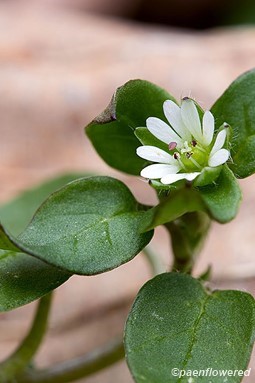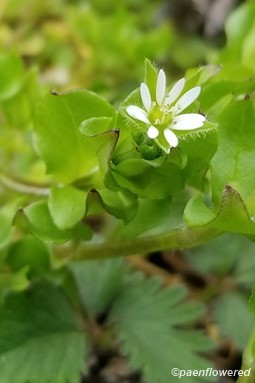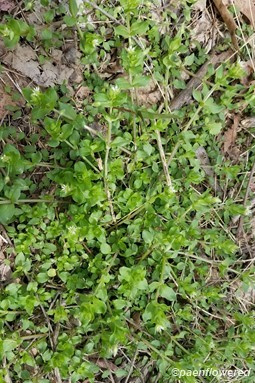Stellaria media
Most common of non-native chickweeds
Stellaria media common chickweed
If there is a plant that most fits the definition of a weed, the common chickweed may be it. Only in a close up photograph can these tiny little flowers be appreciated. It is a member of the pink family and part of the genus Stellaria that includes a number of chickweed species around the world. This species is an alien import from Europe but has become widespread throughout all of North America. It is a winter annual. This means that the seeds germinate in the fall and the plant grows when it can during the late fall and winter. The plant then is able to produce flowers in very early spring.
The ¼ inch flowers have 5 petals, each divided in half. This gives the appearance that it has 10 petals. The flower also has 5 green sepals that are longer than the petals—a key distinguishing trait of the species. There are 3 pistils. The number of anthers varies from 2-10. The flowers often close during cool or rainy weather. The plant continuously produces flowers and sets seed while other blooms are forming.
The leaves are opposite, short and ovate. At night the leaves fold over the growing tip to protect it from the cold. The forked stems have a line of hairs on one side, another trait that distinguishes this plant from other chickweeds. This line changes sides of the stem at each node.
The plant grows 4-16 inches high. Like many invasive species it is found in waste places, along roadsides and in lawns and gardens. It is an agricultural pest, often forming thick, stringy mats. This trait can be beneficial if the plant is used as a ground cover or to control erosion. Control of this weed can be difficult because it produces a large number of seeds over a long period of time.
On the slightly positive side, common chickweed is edible and nutritious and can be used as a salad green. The leaves, however, contain Saponins that give it a soapy taste and which can be toxic in large amounts. Some, though, describe the best as mild and refreshing. Herbalists say that the plant is a treatment for itchy skin, lung disease, and arthritis. A poultice is recommended for cuts, burns and bruises. Most of these herbal treatments have not been scientifically confirmed and should be used with caution. An enzyme found in the plant has been shown to reduce the absorption of dietary fats and carbohydrates and has been suggested but not widely tested as a treatment for obesity.
Habitat & Range
A common weed of fields and gardens.
Present throughout the state.
| EMP: | UPL |
|---|---|
| NCNE: | FACU |
Phenology
Flowers March through November.
Identification Tips
The flower has 5 green sepals that are longer than the petals.









Comments
Have you spotted this plant in your area? We'd love to hear about your experience! Share your comments or questions about the plant below. Comments are moderated before posting.